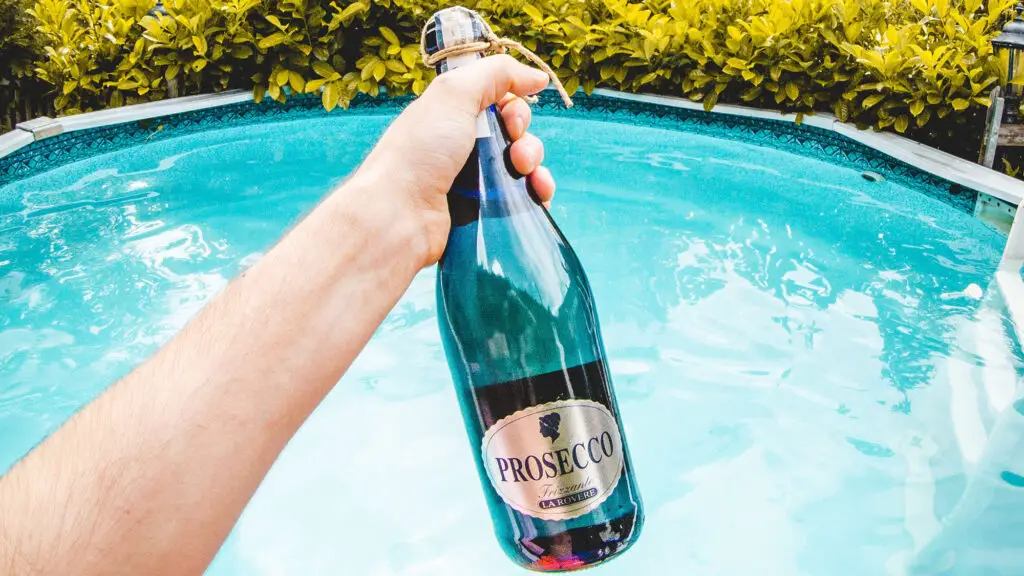During these challenging socially distanced times, holiday gatherings and social events are taking on new electronic formats. That doesn’t mean we can’t pop a bottle and toast our companions! It does mean that you may have extra bubbly left in that coveted bottle of Prosecco. So how do you keep Prosecco fizzy?
While it is not possible to completely stop carbonation loss after a bottle is opened, there are several ways you can keep Prosecco fizzy a little longer. You can keep Prosecco fizzy by using tools like a sparkling wine stopper or plastic wrap and a rubber band to close off the bottle and keep bubbles from escaping. Another proven method to keep your Prosecco fizzy is to constantly keep it cold after it is uncorked.
You may be wondering how that fizz got into the bottle in the first place? The bottle was closed off when you purchased it, and the bubbles didn’t go away. Why can’t you block the opening in the same way?
Let’s first look at what makes Prosecco fizz and how it’s unique. Then we will show you how to keep your zesty refreshment from fizzling out.
Beloved Prosecco

The popularity of this Italian bubbly has exploded over the last decade. World sales have grown double-digit percentage points every year since 2008.
It’s not hard to see why people are lining up to enjoy the famed beverage. Sparkling wine adds excitement to any situation. Prosecco enters with a clean lively impression at an affordable price.
Prosecco is a type of sparkling wine that is often confused with Champagne. The term “sparkling wine” refers to all wine with carbonation. The varietals (or type of grapes) used along with the winemaking process can determine what type of sparkling wine it is.
Author Note: Produced in the area surrounding Venice, the word “prosecco” means “path through the woods.” While there is a town called Prosecco that is essentially the wine’s birthplace, you will find the highest quality from the Veneto and Friuli Venezia Giulia regions.
Prosecco is made from white Glera grapes. It is required that a bottle contains 85% Gerla to add its name to a wine label. Glera’s moderately high acidity and neutral to fragrant profile create a bright, crisp sparkling wine.
Most Prosecco is light and fresh with crisp aromatics often described as pear, apricot, white peach, or apple. It is often used as a palate cleanser but also serves well as an aperitif or accompaniment to almost any type of food.
If you love Prosecco, you are in the company of the historical elite. Even in Roman times, Julia Augustus (Emperor Augusta’s wife) relished the fizzy beverage. Pliny the Elder spoke of its medicinal qualities: “Her 86 years Julia Augusta could thank the wine … for she drank only it and no other… it is believed that there is no better remedy.”
Much time has passed since then yet, we still celebrate this famed beverage.
Is That a Popping Sound I Hear?
Wine gets its fizz from carbon dioxide like many other beverages. Believe it or not, there can be up to 50 million bubbles in a bottle of sparkling wine!
Carbon dioxide influences the taste of sparkling wine. It provides texture in your mouth while the bubbles carry the wine’s aromas to your nose.
During the winemaking process, carbonation is created during the second fermentation when sugar and yeast cells are added, called triage. The sugar consumes the yeast releasing carbon dioxide that is trapped in the wine.
There are several methods vintners (winemakers) use to make sparkling wines. The different methods affect the bubbles that influence a wine’s taste and texture. Prosecco follows the Charmat, or Tank, method.
The second fermentation process takes place in large pressure controlled stainless steel tanks instead of in individual bottles like Champagne’s traditional method. When the desired pressure is reached, the tanks cool the wine to stop the rapid fermentation. This retains the freshness and fragrant characteristics of Glera grapes.
Unlike the traditional method, the tank method is less labor-intensive and doesn’t require aging. That means that by using the tank method, Prosecco can be produced faster at a lower cost. That’s right, More pop for your buck!
Now that you have some background on Prosecco, let’s talk about the different types.
Effervescence and Sweetness

To make matters more confusing, all Proseccos are not the same. Have you ever gawked at a shelf at a store and wondered what’s with the “ante” this and “sec” that?
There are different types of Prosecco classified by how bubbly and sweet it is.
Author Note: Because Prosecco is fermented in large tanks, with less pressure than bottle fermentation, it tends to have light fizzy bubbles. Effervesce will last longer than beer but not as long as Champagne.
Wines that have lower pressure often taste smooth and creamy. This adds a nice balance to Prosecco’s fresh characteristics.
The most popular variety of Prosecco, called Spumante, is fully sparkling with longer-lasting bubbles. Frizzante means a Prosecco is semi-sparkling. The third type, Tranquillo, is flat (no bubbles). You will likely not come across it as it is rarely made this way.
Proseccos’ residual sugar can vary. The level of sweetness is labeled as follows from driest to sweetest: Brut, Extra Dry, Dry, and Demi-Sec. A five-ounce serving of extra-dry will cost you around 95 calories.
Glera grapes, which are used to make Prosecco, are high in acid. Wines with high acid tend to have lower alcohol than others.
Look for bottles with the most recent vintage dates. Since Prosecco isn’t fermented in a bottle, it doesn’t age well. Drink young Prosecco for the best taste and aromas.
Getting the Most Fizz and Flavor Out of Your Prosecco
Contrary to what you might think, it’s best not to store Prosecco in your refrigerator for long periods before you plan to open it. Light exposure can alter your wine. The vibrations from the fridge can wedge the cork out slightly, allowing coveted bubbles to seep out. Always store wine in a cool dark place.
Prosecco is best served chilled around 38–45 °F / 3–7 °C. Warmer wine comes across as sweeter than cold wine. You can vary the temperature based on your preference.
Pop the bottle in the refrigerator no more than a couple of days before drinking. You can also fill an ice bucket (or sink in a pinch) with half ice, half water, and a little salt. This works well for all sparkling wines, including champagne.
The best stemware for Prosecco is a Tulip glass. It has a wider base than a flute with a narrow top. A wine glass or flute can also be used. Be sure to pour Prosecco down the inside of a titled glass like you would a beer.
While it may not make a huge impact, keep in mind that things like greasy food, lipstick, or soap residue left on your glass can break up bubbles.
How to Keep Prosecco Fizzy by Temperature
The best way to preserve those bubbles is to keep your wine cold. Carbon dioxide does not stay dissolved in warm liquid. Leaving Prosecco on the counter will warm the wine resulting in a faster fizzle.
From the moment you open a bottle of Prosecco, be sure to keep the bottle on ice or in your fridge. Never put sparkling wine in the freezer – it will explode.
If you don’t finish the bottle keeping it consistently cold is key to keeping your Prosecco Fizzy.
How to Keep Prosecco Fizzy with a Sparkling Wine Stopper
If you often have leftover bubbly, you may want to consider purchasing a sparkling wine stopper. Some claim to keep wine good for a week. These are hermetic (airtight) stoppers that usually have some type of clip that secures the stopper.
Sparkling wine stoppers can be purchase anywhere from $10 to $400.
Never use a regular wine stopper for sparkling wine. The pressure in the wine will make it shoot off in your fridge.
How to Keep Prosecco Fizzy with Plastic Wrap

This trick is easy and something you usually have on hand. Plastic wrap is flexible enough to expand but still able to trap air. Wrap a piece of plastic wrap over the open mouth of the bottle the secure it with a rubber band.
Sparkling wines can hold around three times the pressure in your car tire. The elasticity in plastic wrap stretches out slightly while trapping the bubbles in your bottle.
How to Keep Prosecco Fizzy with a Spoon
That’s right! a spoon will keep your prosecco fizzy. Place the handle of a tablespoon (preferably silver) into the neck of your open bottle. Place it in the refrigerator until your next glass.
Author Note: The theory is that the metal cools the air inside the bottle. Cold air increases air density. Denser air covers the wine’s surface preventing bubbles from escaping.
Keep in mind that opened wine can absorb smells from your refrigerator. It’s best to keep it in a wine cooler if possible.
This method is widely debated. Many people swear by it while others claim they have debunked the wives tale as a myth. Why not give it a try and see if it works for you.
Raise Your Glass
Not being able to finish a bottle should never prevent you from popping that Prosecco. Always keep your wine cold and try using a spoon, sparkling wine stopper, or plastic wrap and a rubber band to keep your Prosecco Fizzy.
Prosecco is a celebrated wine that increases the excitement of any occasion. Grab a bottle and start your virtual toasts!
To living a full-bodied life,
Wesley

